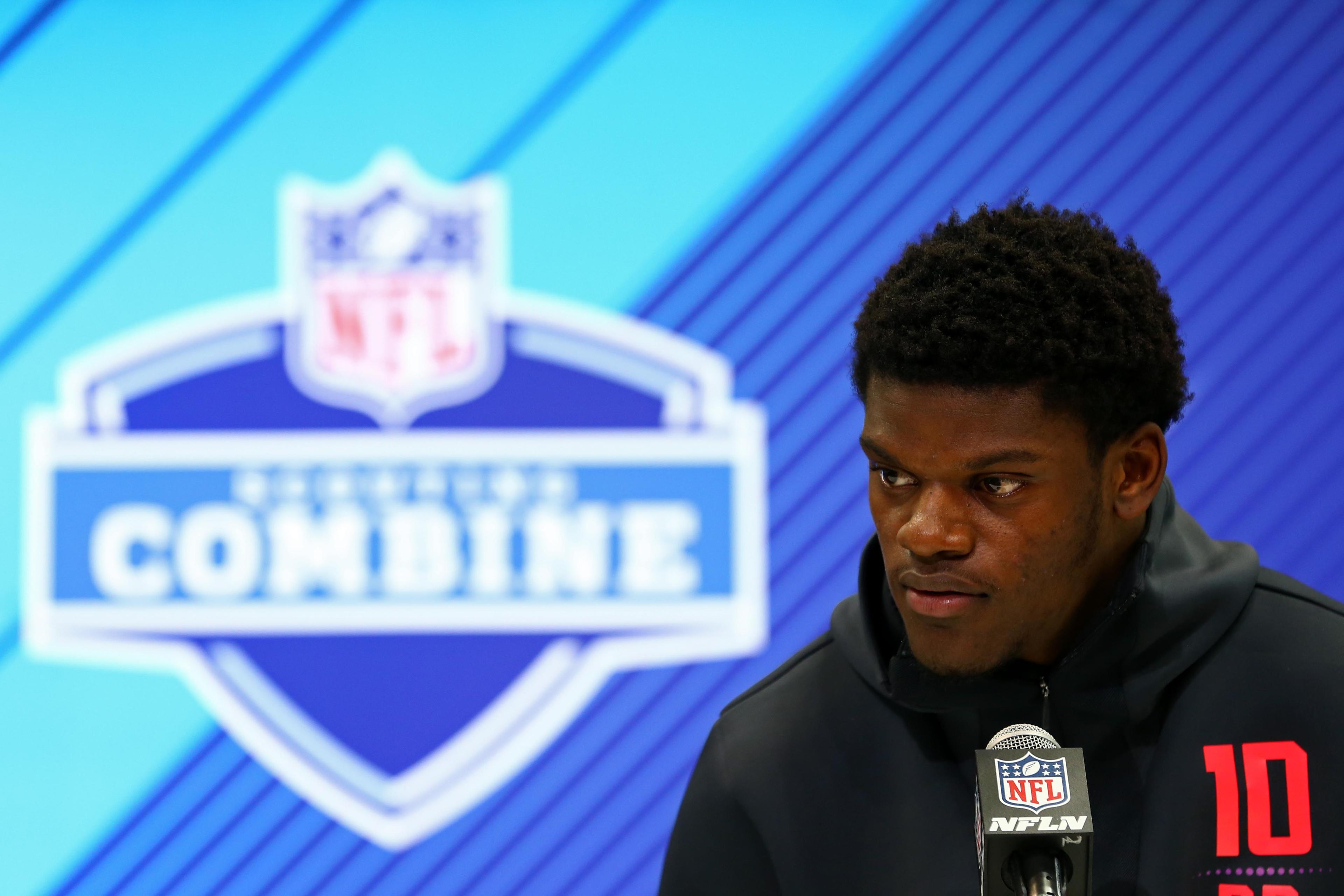
We can’t believe it, either, but “Nick Foles, Super Bowl MVP” is old news. The 2018 NFL combine is already here, and a rotating cast of Ringer staffers will provide you with a collection of five thoughts from each day in Indianapolis.
1. The “Is Lamar Jackson a Quarterback?” Debate Isn’t Going Away
A few weeks back, it was easy to scoff at the suggestion of former Bills and Colts executive Bill Polian that Louisville quarterback and 2016 Heisman Trophy winner Lamar Jackson make the switch to receiver in the NFL. Polian justified his belief in a few ways: first, by saying that Jackson is “short and slight,” which is empirically inaccurate (he measured in at 6-foot-2, 216 pounds at the combine this week, the same height as Aaron Rodgers and the same weight as Andy Dalton) and, second, by saying that Jackson’s “accuracy isn’t there,” which is legitimate (Jackson completed 57.0 percent of his passes in three seasons at Louisville). The accuracy concern is also worth mentioning about another projected first-round quarterback prospect: Wyoming’s Josh Allen. Allen finished his college career with a 56.2 completion percentage, yet some scouts think he could go first overall in April’s draft. Both Jackson and Allen have displayed many other traits and tools necessary for playing quarterback in the NFL, so the concept of Jackson alone making a preemptive position change felt like a completely absurd suggestion. Right?
Well, Polian may not be alone in his opinion. As Good Morning Football’s Peter Schrager reported on Friday, multiple NFL teams have requested that Jackson work out as a receiver at the combine this week, in addition to his quarterback workouts.
At best, that request feels like an insult to a guy who threw for 9,043 yards and 69 touchdowns, averaged 8.3 yards per attempt, and registered a 142.9 passer rating during his illustrious career in Louisville’s pro-style passing game. At worst, it seems to hint at racial bias. It also suggests there’s a handful of teams that are still unwilling to build an offense around Jackson’s skill set: A dynamic runner and passer, his game is perfect for a scheme featuring designed runs, the heavy use of play-action, run-pass options, and quarterback movement. The former Cardinals playmaker ran for more than 4,100 yards and scored another 50 rushing touchdowns during his college career.
Teams must protect their franchise players from injury, but when utilized judiciously, a quarterback who can run places extreme pressure on a defense. A few teams — the Texans, Panthers, Chiefs, and Super Bowl champion Eagles — have embraced these “college” ideas, and each has had success with them.
On Thursday, Seahawks head coach Pete Carroll spoke about some teams’ reluctance to adopt a type of offense that takes its quarterback out of the pocket and puts him on the move. “I think it does have to do with the coach’s background, and how much appreciation they have for that style of play — and [whether] they have any experience with it,” Carroll said, adding that coaches with a history in defensive game-planning may be more willing to run that type of offense. “If you are a defensive coach who has defended those guys, you may be more excited about that thought because it’s so hard of an element to deal with.”
But you don’t have to be a defensive coach to appreciate what a dynamic dual-threat quarterback can do. Chargers head coach Anthony Lynn, a former running backs coach, offensive coordinator, and interim head coach with the Bills, implemented an innovative system in Buffalo that incorporated Tyrod Taylor as a runner. This week, Lynn spoke in Indianapolis about how a player with that skill set can change the math for the defense. “When you have a guy who can move around a little bit like Lamar, you make a defense play 11-on-11 [compared to a scheme with a less-mobile quarterback, where defenses have an 11-on-10 advantage in the run game]. That’s a defensive coordinator’s worst nightmare.”
Of course, Jackson wouldn’t be the first college quarterback to make a switch to receiver. But on the other hand:
Jackson seemed to rule out a move to wideout when he met with the media on Friday. (He also denied that any team had asked him to work out at receiver, for what it’s worth.) But odds are, we’ll be hearing this quarterback-vs.-receiver debate until the draft kicks off — and potentially beyond.
2. Orlando Brown’s Stock Is About to Plummet … or Is It?
Brown’s performance this week will be a great litmus test for just how much the workout portions of the combine really matter for offensive line prospects. Sure, every year there’s a handful of players at the position who test off the charts, and those performances can help propel them up draft boards. But for the most part, as long as the top players at each offensive line spot perform acceptably to scouts and coaches, that player’s game tape will be the real determining factor in their evaluations.
Brown’s tape from college already told us that he lacked top-end athleticism. But the 6-foot-8, 345-pound former Oklahoma left tackle still came into the combine as one of the top tackle prospects, and given his combination of rare size and length (he measured out with an 85.5-inch wingspan this week) a probable first-round pick. After Friday, though, all bets are off. Brown ran the 40-yard dash in 5.85 seconds (the fifth-slowest time for any player over the past 15 years), jumped just 19.5 inches in the vertical (third worst all time), leaped 82 inches in the broad jump (worst since 2000), and put up just 14 reps on the bench press (fourth-worst among offensive linemen this year).
Brown will have a chance to make a better impression at Oklahoma’s pro day on March 14, and in private workouts with teams before the draft. But this week’s performance could have teams shuffling their draft boards.
3. Injuries: An Unfortunate Byproduct of the Combine Process
The purpose of the combine is to measure prospects’ athleticism against a baseline level set by past participants. But a lot of these tests feel pretty unnecessary — especially the bench press.
That’s why it was frustrating to see Ohio State center Billy Price forced to cut his bench press test short after walking off in substantial pain on Friday morning. It was later revealed that Price had partially torn his pectoral muscle, meaning his combine — the physical part, anyway — is essentially over before it got started. Price seemed to think he’d escaped major injury, but it does put preparation for his rookie season on hold, and if surgery is required, may hurt his draft stock.
USC running back Ronald Jones also pulled up with a hamstring injury on Friday when he attempted his first 40. His combine is also over, but he should be able to test at USC’s pro day on March 21.
4. Josh Rosen Makes His Case As Best Quarterback in the Class
Friday was a day for proclamations: Baker Mayfield, Allen, and Rosen each declared themselves the best quarterback in this draft class. And while we’ll have to wait a few years to find out who’s right, something Rosen said stood out. When asked about his greatest on-field attribute, the former UCLA signal-caller cited his ability to make quick decisions:
“I’m very quick and decisive; I always say that I think if you can [get] three or four reads into your progression, you give yourself more opportunities to get the ball down the field,” he said. “If you’re a one-to-two [read] and run guy, and you throw the ball [30 or] 40 times a game, you’re giving yourself 70 to 80 opportunities to get the ball down the field.
“If you can get into one, two, three and four [in your read progression], then you’re giving yourself 150 to 160 — twice as many opportunities — to actually push the ball down the field. So that’s where I think my best attribute is: I can sit in the pocket and really pick defenses apart.”
That’s an interesting way of trying to quantify his value relative to his peers. The ability to push the ball down the field is an important variable in a league that’s leaning increasingly on short passes to move the ball. Part of the reason for that trend is that modern college quarterbacks often find the transition from the college game to the pros difficult: Quarterbacks coming from college spread schemes are used to easy and defined half-field reads with the goal of getting the ball out as quickly as possible. The downside, of course, is that if a quarterback can’t go through read progressions quickly and efficiently, plays completely break down when the primary target isn’t open.
Let’s say Rosen’s right, and he can bring an ability to cycle through his options to the pros: That’s a powerful attribute for whatever offense he’s running, and it’ll enhance his team’s ability to create explosive plays in the passing game.
5. The Saquon Barkley Show Continues
This class of quarterbacks represents the biggest draw in Indianapolis this week, but there’s little doubt that Barkley has taken the early lead in the race for the Combine Championship Belt. On Thursday morning, he pushed out 29 reps in the 225-pound bench press — seventh most all time for a running back — then impressed with a cool, confident demeanor in his press conference later that day. Friday, Barkley ran a 4.40 in the 40-yard dash — good for second among all running backs, just two-tenths of a second slower than position-group leader Nyheim Hines of NC State, whom Barkley outweighs by 35 pounds. With a 4.40 time at 233 pounds, Barkley’s speed score of 124.3 ranks fourth all time among running backs.
Barkley also jumped 41 inches in the vertical, best in the running backs group. For some context of what he did on Friday, consider this:
There’s no doubt: Barkley has lived up to the pre-combine hype, and then some.

